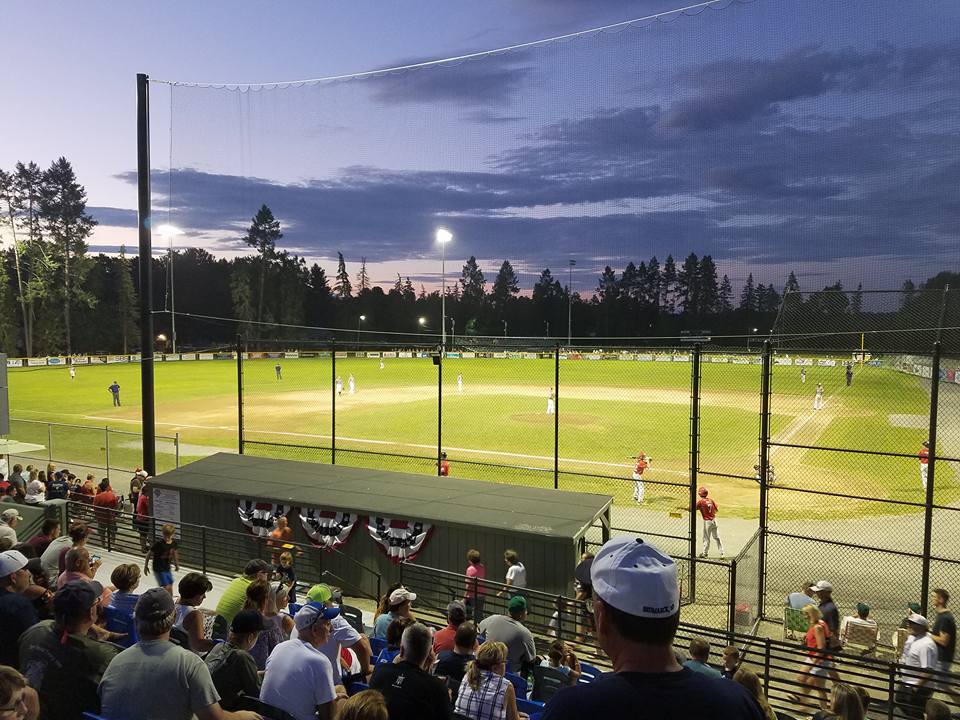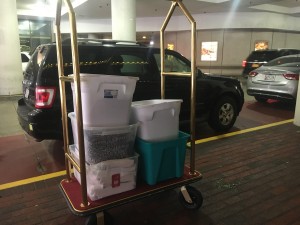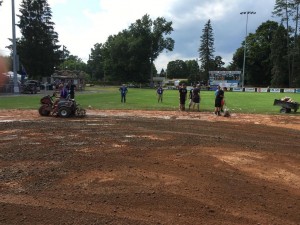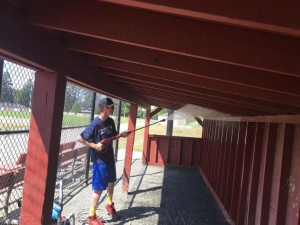WESTFIELD—While the players were at the center of the Babe Ruth World Series, it was the volunteers that helped make the games happen.
Volunteers from around the community came together to make sure everything went as well as it could for the 12 teams and the thousands of spectators over the seven-day tournament. Volunteers not only came out to help during the 33 games that were played, but also before and after, performing tasks that were not seen or heard but still made a difference for everyone involved.
“The volunteer effort really made the difference for us,” Dan Welch, Westfield Babe Ruth League President, said. “Many people came back and helped again because they liked it so much the first time. It really shows how the city supports youth athletics.”
Jobs for the tournament included ticket sales, souvenir booth operation, broadcast work, food preparation and field work. However, the dirtiest of the jobs may have been doing laundry for the teams. And this task fell to Beth Baldwin and Nancy Amanti.
Beth, who is the wife of the Westfield Babe Ruth’s chairman of the administrative division Dick Baldwin, said that she was given the task of cleaning uniforms after a team inquired about laundry services from the league.
“Dick found out there was only one washer and dryer at the hotel and we knew we had to provide them with something else,” Beth said. “Push comes to shove and people closest to the phone call get the opportunity.”
She said that they offered the laundry services to all of the traveling teams who were staying in the area, so Pittsfield and Westfield were not part of the mix. Of the 10 remaining teams, four of them chose to have their laundry done by Beth and Amanti.
Beth said that the plan was to clean all the uniforms at laundromats, but when one of the nights were delayed until past midnight, there were no places open to do laundry.
So, she had to take the work home with her.
Beth said that she spent that night soaking the uniforms and attempting to get out the quick-dry chemicals that soaked up moisture off the field and cleaning several loads of laundry. She had to work through the night, taking one-hour naps between loads. However, she stressed that she was at least able to sleep in her own bed.
At one point though, Beth’s workload did get easier, since the visiting Maine team decided that they didn’t need their uniforms washed anymore because they were on a winning streak, became superstitious and decided not to wash their uniforms. Sort of like what Wade Boggs did.
Beth could not give a concrete total of uniforms that she washed, but she gave an estimate.
“I did about 700 dirty pieces of stinky stuff,” she said.
The laundry was done pro bono, but the teams who had their uniforms washed donated a total of $401 to the Westfield Babe Ruth League in appreciation of the effort.
Other work behind the scenes included the many broadcast efforts done to get the games to a wider audience. To coordinate this, Peter Cowles, media and communications director and volunteer for the games, organized a group of about 30 individuals to help run cameras, do play-by-play, announce and other technical work.
Cowles said that the both the age and experience level of the volunteers who helped on the broadcast side ranged broadly, but that they all did an excellent job in their respective roles.
“Everything from professional broadcasters to college students to first timers came to help,” Cowles said. “People just got really excited about it. I had a ton of people and it was a whole lot of fun.”
Cowles was able to even get assistance from local politicians who knew that he needed help. Ward 6 City Councilor William Onyski, along with At-Large Councilors Steven Dondley and Daniel Knapik all helped the broadcast teams, with Knapik and Dondley announcing for some games and Onyski running a camera for several.
Onyski admitted that he had no experience with camera work, but wanted to help when Cowles said he needed it. Overall, it appeared to go well.
“There was a learning curve,” Onyski said. “Even though you’re in the broadcast booth you’re not watching the game on the field, you’re watching it on a little screen with an ever so slight delay, so you hear the crack of the bat but you have to wait to see it on the screen.”
Cowles said that while they cannot tally the total amount of viewers and listeners between television and radio, the amount of Internet views was large.
“So far, including the live broadcast and views, we are up over 40,000 views and 840,000 minutes viewed,” Cowles said on Monday.
“We had 5,000 views a day minimum—some days it was up to 8,000—and people are still watching videos today,” he said.
Other work that had to be done for the games to go swimmingly included a lot of field and stadium preparation. Mike Roundy, who was the chairman of the stadium division, had to organize the work to be done on the field, as well as what happened with the stadium.
Roundy said that the most strenuous moment for preparation came when weather wouldn’t cooperate.
“Between games we would tend to the mound, then we would groom the field and we would redraw the lines—you can do that in a half hour no problem,” he said. “But the problem we had was with pop up showers, so we would have to spread a drying compound and it would take a couple hours to get the field ready.”
He said that while he had a core group of six individuals, there were people in the hundreds that came to help with whatever was needed. This included people who came to the field on Sunday, August 14, at 6 a.m. to prepare the field. The game the night before was rained out and the field had to be ready for 8:30 a.m.
“The impressive thing to me was the number of volunteers that would just jump in,” Roundy said. “A shower would come and a dozen people would come and help with the tarp, or when it would end would help get the tarp off the field.
“A number of them didn’t have kids in the tournament but just wanted to help,” he said. “It was great to see the community shining through.”
Chris Gezotis, volunteer coordinator for the tournament, said that all of these individuals and others helped make the games go well in spite of the many headaches and moments of chaos that presented for the group.
She was unable to give an accurate number of volunteers, but estimated that it was around 350 people who came to help. Also, she mentioned that the police and fire departments, as well as the Westfield Emergency Corps that handled all medical issues were excellent to everyone.
“Everybody loved it, all the visitors loved it,” Gezotis said. “We heard nothing but good stuff.
“Even though we were struggling people didn’t see it—it was organized chaos.”





